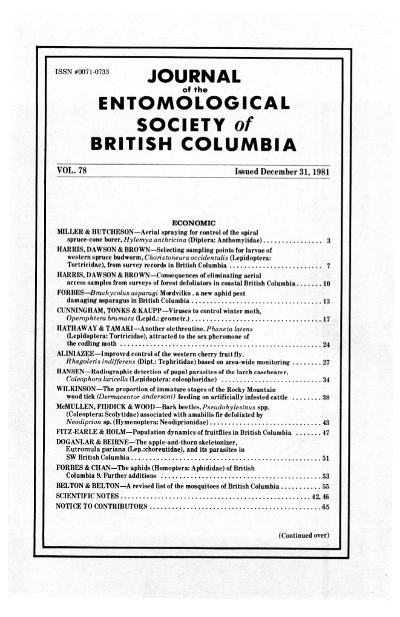Consequences of eliminating aerial access samples from surveys of forest defoliators in coastal British Columbia
Abstract
Larval populations of forest defoliators in British Columbia are assessed at least once each year by beating trees at scattered permanent sampling stations. These data are supplemented by additional, randomly selected samples. Most stations are reached by road, but aircraft are used to reach some roadless areas. Recently, to economize, large blocks of aircraft access permanent sampling stations were dropped. To learn how this affected the estimates of overall population numbers, we compared past records determined with and without aerial samples and with and without random samples. The northern mainland coast and the west coast of Vancouver Island were selected as test sites. In most instances, defoliator populations as measured at aerial and ground access permanent sampling stations and by random samples rose and declined together, indicating that estimates of population trend would not be seriously affected by dropping aerial and random samples.References
Harris, J.W.E., D.G. Collis, and K.M. Magar. 1972. Evaluation of the tree-beating method for sampling defoliating forest insects. Can. Ent. 104:723-729.
Harris, J.W.E. 1976. Storage and retrieval of quantitative British Columbia-Yukon Forest Insect and Disease Survey records. Can. Forest. Serv., Pac. For. Res. Cent. Info. Rept. BC-X-120. 30 pp.
Downloads
Published
Issue
Section
License
Authors who publish with the Journal of the Entomological Society of British Columbia agree to the following terms:
-Authors retain copyright and grant the journal right of first publication with the work simultaneously licensed under a Creative Commons Attribution License that allows others to share the work with an acknowledgement of the work's authorship and initial publication in this journal.
-Authors are able to enter into separate, additional contractual arrangements for the non-exclusive distribution of the journal's published version of the work (e.g., post it to an institutional repository or publish it in a book), with an acknowledgement of its initial publication in this journal.
-Authors are permitted and encouraged to post their work online (e.g., in institutional repositories or on their website) prior to and during the submission process, as it can lead to productive exchanges, as well as earlier and greater citation of published work (See The Effect of Open Access).


